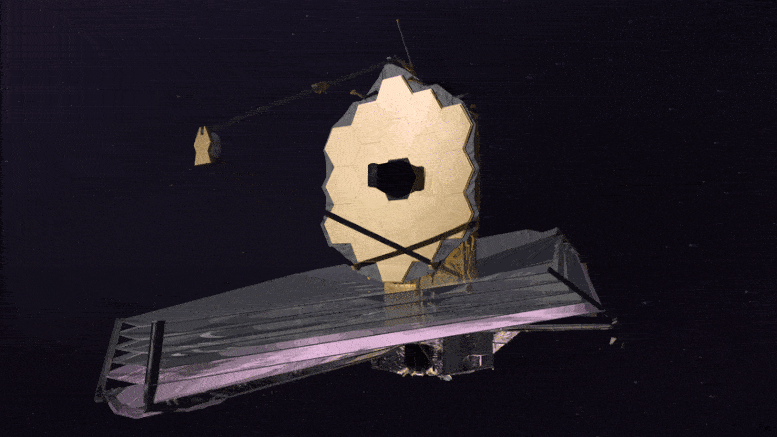
NASA’s James Webb Space Telescope. Credit: NASA’s Goddard Space Flight Center Conceptual Image Lab
Webb will tackle the challenge of the supermassive black hole’s puzzling flares, which have proved both intriguing and frustrating for astronomers.
In its first year of operations, NASA’s James Webb Space Telescope will join forces with a global collaborative effort to create an image of the area directly surrounding the supermassive black hole at the heart of our Milky Way galaxy. The Event Horizon Telescope (EHT) is famous for its first image of the “shadow” of the black hole at the core of galaxy M87, and it has now turned its efforts to the more complex environment of Sagittarius A*, the Milky Way’s supermassive black hole. While M87’s core presented a steady target, Sagittarius A* exhibits mysterious flickering flares on an hourly basis, which make the imaging process much more difficult. Webb will assist with its own infrared images of the black hole region, providing data about when flares are present that will be a valuable reference to the EHT team.
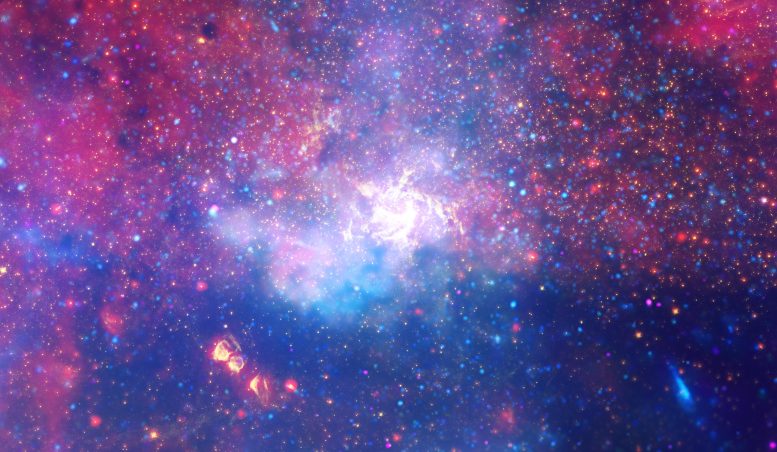
An enormous swirling vortex of hot gas glows with infrared light, marking the approximate location of the supermassive black hole at the heart of our Milky Way galaxy. This multiwavelength composite image includes near-infrared light captured by NASA’s Hubble Space Telescope, and was the sharpest infrared image ever made of the galactic center region when it was released in 2009. Dynamic flickering flares in the region immediately surrounding the black hole, named Sagittarius A*, have complicated the efforts of the Event Horizon Telescope (EHT) collaboration to create a closer, more detailed image. While the black hole itself does not emit light and so cannot be detected by a telescope, the EHT team is working to capture it by getting a clear image of the hot glowing gas and dust directly surrounding it. Credit: NASA, ESA, SSC, CXC, STScI
On isolated mountaintops across the planet, scientists await word that tonight is the night: The complex coordination between dozens of telescopes on the ground and in space is complete, the weather is clear, tech issues have been addressed—the metaphorical stars are aligned. It is time to look at the supermassive black hole at the heart of our Milky Way galaxy.
This “scheduling Sudoku,” as the astronomers call it, happens each day of an observing campaign by the Event Horizon Telescope (EHT) collaboration, and they will soon have a new player to factor in; NASA’s James Webb Space Telescope will be joining the effort. During Webb’s first slate of observations, astronomers will use its infrared imaging power to address some of the unique and persistent challenges presented by the Milky Way’s black hole, named Sagittarius A* (Sgr A*; the asterisk is pronounced as “star”).
In 2017, EHT used the combined imaging power of eight radio telescope facilities across the planet to capture the historic first view of the region immediately surrounding a supermassive black hole, in the galaxy M87. Sgr A* is closer but dimmer than M87’s black hole, and unique flickering flares in the material surrounding it alter the pattern of light on an hourly basis, presenting challenges for astronomers.
“Our galaxy’s supermassive black hole is the only one known to have this kind of flaring, and while that has made capturing an image of the region very difficult, it also makes Sagittarius A* even more scientifically interesting,” said astronomer Farhad Yusef-Zadeh, a professor at Northwestern University and principal investigator on the Webb program to observe Sgr A*.
The flares are due to the temporary but intense acceleration of particles around the black hole to much higher energies, with corresponding light emission. A huge advantage to observing Sgr A* with Webb is the capability of capturing data in two infrared wavelengths (F210M and F480M) simultaneously and continuously, from the telescope’s location beyond the Moon. Webb will have an uninterrupted view, observing cycles of flaring and calm that the EHT team can use for reference with their own data, resulting in a cleaner image.
The source or mechanism that causes Sgr A*’s flares is highly debated. Answers as to how Sgr A*’s flares begin, peak, and dissipate could have far-reaching implications for the future study of black holes, as well as particle and plasma physics, and even flares from the Sun.
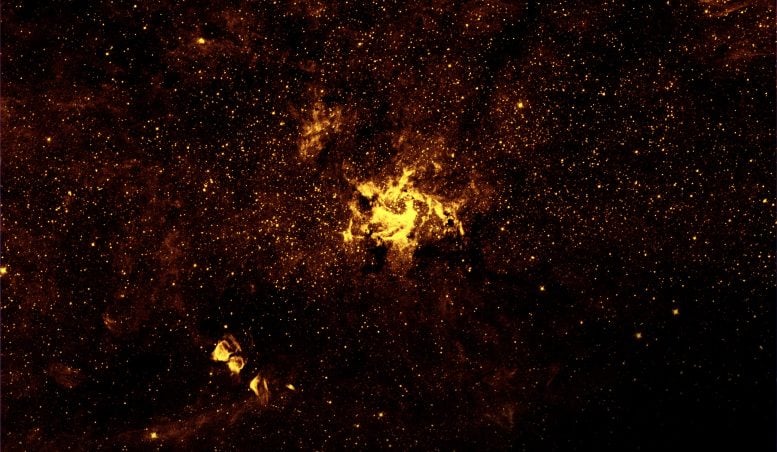
Heated gas swirls around the region of the Milky Way galaxy’s supermassive black hole, illuminated in near-infrared light captured by NASA’s Hubble Space Telescope. Released in 2009 to celebrate the International Year of Astronomy, this was the sharpest infrared image ever made of the galactic center region. NASA’s upcoming James Webb Space Telescope, scheduled to launch in December 2021, will continue this research, pairing Hubble-strength resolution with even more infrared-detecting capability. Of particular interest for astronomers will be Webb’s observations of flares in the area, which have not been observed around any other supermassive black hole and the cause of which is unknown. The flares have complicated the Event Horizon Telescope (EHT) collaboration’s quest to capture an image of the area immediately surrounding the black hole, and Webb’s infrared data is expected to help greatly in producing a clean image. Credit: NASA, ESA, STScI, Q. Daniel Wang (UMass)
“Black holes are just cool,” said Sera Markoff, an astronomer on the Webb Sgr A* research team and currently vice chairperson of EHT’s Science Council. “The reason that scientists and space agencies across the world put so much effort into studying black holes is because they are the most extreme environments in the known universe, where we can put our fundamental theories, like general relativity, to a practical test.”
Black holes, predicted by Albert Einstein as part of his general theory of relativity, are in a sense the opposite of what their name implies—rather than an empty hole in space, black holes are the most dense, tightly-packed regions of matter known. A black hole’s gravitational field is so strong that it warps the fabric of space around itself, and any material that gets too close is bound there forever, along with any light the material emits. This is why black holes appear “black.” Any light detected by telescopes is not actually from the black hole itself, but the area surrounding it. Scientists call the ultimate inner edge of that light the event horizon, which is where the EHT collaboration gets its name.
The EHT image of M87 was the first direct visual proof that Einstein’s black hole prediction was correct. Black holes continue to be a proving ground for Einstein’s theory, and scientists hope carefully scheduled multi-wavelength observations of Sgr A* by EHT, Webb, X-ray, and other observatories will narrow the margin of error on general relativity calculations, or perhaps point to new realms of physics we don’t currently understand.
As exciting as the prospect of new understanding and/or new physics may be, both Markoff and Zadeh noted that this is only the beginning. “It’s a process. We will likely have more questions than answers at first,” Markoff said. The Sgr A* research team plans to apply for more time with Webb in future years, to witness additional flaring events and build up a knowledge base, determining patterns from seemingly random flares. Knowledge gained from studying Sgr A* will then be applied to other black holes, to learn what is fundamental to their nature versus what makes one black hole unique.
So the stressful scheduling Sudoku will continue for some time, but the astronomers agree it’s worth the effort. “It’s the noblest thing humans can do, searching for truth,” Zadeh said. “It’s in our nature. We want to know how the universe works, because we are part of the universe. Black holes could hold clues to some of these big questions.”
NASA’s Webb telescope will serve as the premier space science observatory for the next decade and explore every phase of cosmic history—from within our solar system to the most distant observable galaxies in the early universe, and everything in between. Webb will reveal new and unexpected discoveries, and help humanity understand the origins of the universe and our place in it. Webb is an international program led by NASA with its partners, ESA (European Space Agency) and the Canadian Space Agency.

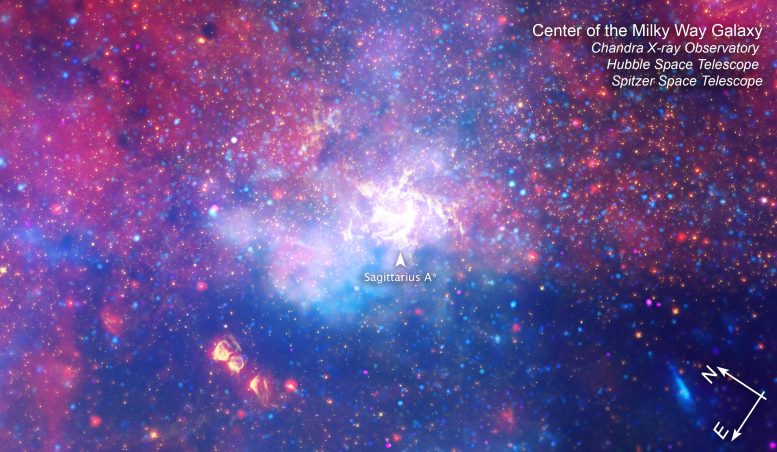

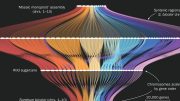



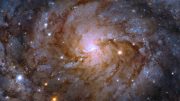


all measurements approximates
sagittarius a event horizon 10,000,000 kilometres radius and contrary to what you suppose a vortex of empty space here exists between the centre axis line and the circumference
here exists also the beam of hot gamma rays a column of rays that extends 25,000 light years out into our intergalactic local bubble of space
the ultimate inner edge of that light the event horizon interior 10,000,000 kilometres radius
sagittarius a 11,800,000 kilometres 7,300,000 miles in radius
sagittarius a 23,600,000 kilometres 14,600,000 miles in diameter
with a
black hole size of orbit of venus 106,216,714 kilometres 66,000,000 miles
from this accretion disc is emitted the soft x ray beams and hard x ray beams that flow out to form the rosita bubble over the entire milky way galaxies central bulge
followed by
accretion disc 5 x orbit of venus = 531,083,570 kilometres 330,000,000 miles or 3.5 au to 475,000,000,000 kilometres or 3.168au diameter
the area that you are trying to observe that exhibits mysterious flickering flares in the material surrounding it altering the pattern of light on an hourly basis
flaring begins peaks dissipate calm flaring begins again peaks dissapates calm flaring begins again particle and plasma studies
the ultimate outer edge of that light the event horizon exterior
but the black hole itself from the image you show
does it rotate clock wise or anticlock it looks anticlock from where i look from my computer image
but have you observed red shift or blue shift in this area to confirm same
but did you also observe as you look at the image
the size of the object concerned in 3d
accretion disc 5 x orbit of venus = 531,083,570 kilometres 330,000,000 miles or 3.5 au to 475,000,000,000 kilometres or 3.168au diameter
this object is extending 10,000 light years down the cylinder of the central axis of the milky way and which your image is showing approximately 2000 light years of the 10,000 light years height
and it is this object 3.5 au x 10,000 light years height that is the fundamental force that rotates the galaxies five arms around the galactic centre
the strong force that binds the galaxy together
the gravity force that sucks all those stars into its arms and embraces them in a galactic bear hug
so now that we have discovered the strong force and the gravity force
where lies the weak galaxy force
well is you travel down the 10,000 light year tunnel there you will come to the centre of the galaxy and as you will be informed as you read these lines with your own eyes there lies the weak force
so all thats left is the electromagnetic force
the dark matter force
the dark energy force
and the spatial vector force
to complete the picture
which i know all you cosmologists physicts and astronomers will be able to explain in full techicolour detail how it works on a milky way galactic scale
just as i have explained and informed you of the three i know
i await to be informed post haste and i hope not by snail mail post
? I don’t know what you are trying to say.
But I note that the fundamental forces – which includes the weak force – is everywhere and not connected to, say, the Milky Way as you seem to say.
This cash cow is going to fail. just sayin’
I really hope it doesn’t, but I do have my fears. It is incredibly complex, with so many points of failure (especially with the heat shield deployment.) Plus all the problems and delays during development doesn’t bode well. In addition, the Ariane 5 isn’t the most trustworthy launch platform.
It will be an incredible observatory if all goes well, but there is some risk of failure.
That would be costly, as well as bad for science.
But chances is it will not.
Thank you for an informative article about The Milky Way’s black hole surroundings and the coordination of old telescopes and the new Webb telescope!
Waste of money time.
? Science has among the best return on investment, says statistics.
We invest too little in it. more likely.
The flare of Sgr A* has rigid fixed proporties.These prorties are areal considered for total accretion disc,starting from event horizon.The proporty,namely brightness of visible ligt flikering has a fixed time period.Proporties are directly proportional to the mass of Sgr A*.A fixed constant of proportionality is present for all galaxìes,when total area of accretion disc is considered.
Now law of relativity is passed for all stars/black holes with above law.
For other galaxies :
With linear velocity as per Hubble’s law,rotation is added for acceleration correspondingly.
So law of general relativity is applicable.
NOT called Webb telescope!!
Because of Public Information about James Webb, when he represented NASA at the State Dept in the 1950s, this telescope will retain its original NASA name. Scientists who weighed in on it, and The Public voted NOT to rename it after Webb, a man responsible for the firing of many LGBQ people at NASA, was exposed.
? It is the James Webb Space Telescope [ https://en.wikipedia.org/wiki/James_Webb_Space_Telescope ].
I doubt a public campaign can rename what the involved scientists once named, and there is no good reason for it.
Or we could spend that money on SOLVING THE WORLDS PROBLEMS!? Starvation, War, Corruption, sickness, pollution!?!
We are absolutely INSANE as a species. We look for answers, love, happiness, spirituality, god, enlightenment, all outside of ourselves, when it’s ALL within us.
Focus on the earth and our problems here! 10 billion dollars on a telescope to look away from the problems we face on earth.
What an expensive distraction.
Morons.
That’s what science do! You should maybe ask for more money for it, since science is so useful.